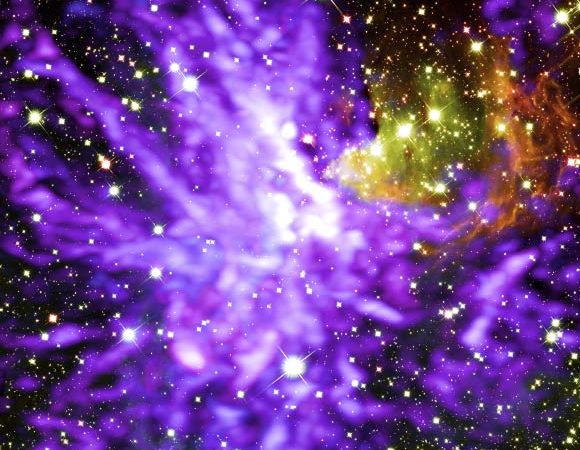Using the Atacama Large Millimeter/submillimeter Array (ALMA) and the NASA/ESA Hubble Space Telescope, astronomers have observed G286.21+0.17, a massive protocluster located some 8,000 light-years away in the constellation of Carina.
Source: Sci News
ALMA observed the motions of turbulent molecular gas (purple ‘fireworks streamers’) falling into the cluster, forming dense cores that ultimately create individual stars.
The stars in the composite image are revealed by their infrared light, as seen by Hubble, including a large group of stars bursting out from one side of the cloud.
The powerful winds and radiation from the most massive of these stars are blasting away the molecular clouds, leaving faint wisps of glowing, hot dust (yellow and red).
“This image shows stars in various stages of formation within this single cluster,” said Dr. Yu Cheng, an astronomer at the University of Virginia and lead author of two papers published in the Astrophysical Journal.
Hubble revealed more than 5,000 young stellar objects, of which 562 show signs of a circumstellar disk, with a wide range of masses.
Additionally, ALMA showed that there is a lot more mass present in dense gas that still has to undergo collapse.
“Overall the process may take at least a million years to complete,” Dr. Cheng said.
“This illustrates how dynamic and chaotic the process of star birth is,” said co-author Dr. Jonathan Tan of Chalmers University and the University of Virginia.
“We see competing forces in action: gravity and turbulence from the cloud on one side, and stellar winds and radiation pressure from the young stars on the other. This process sculpts the region.”
“It is amazing to think that our own Sun and planets were once part of such a cosmic dance.”
“The phenomenal resolution and sensitivity of ALMA are evident in this stunning image of star formation,” said Dr. Joe Pesce, NSF Program Officer for NRAO/ALMA who was not involved in the study.
“Combined with Hubble data we can clearly see the power of multiwavelength observations to help us understand these fundamental universal processes.”
Source: Sci News

































Leave a Comment
You must be logged in to post a comment.